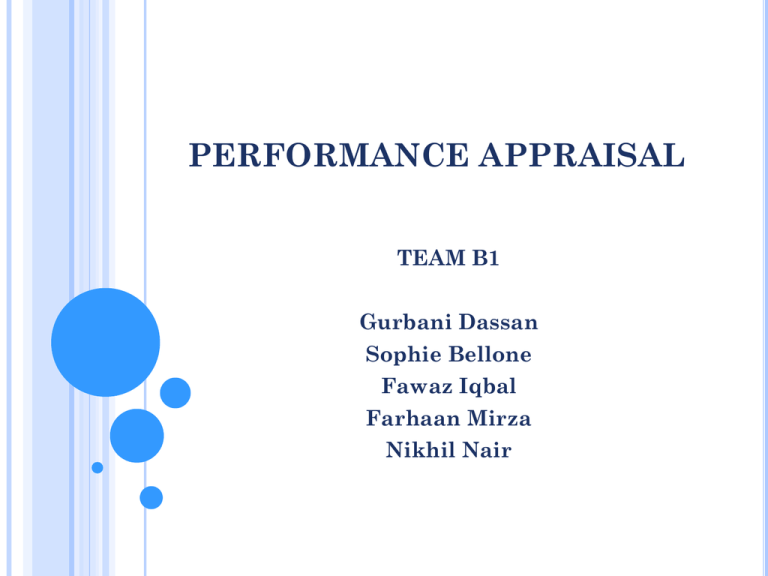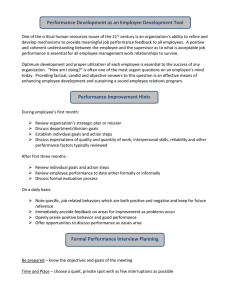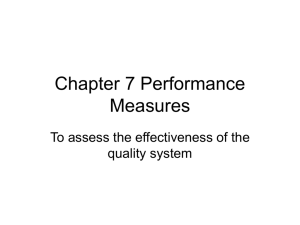PERFORMANCE APPRAISAL
advertisement

PERFORMANCE APPRAISAL TEAM B1 Gurbani Dassan Sophie Bellone Fawaz Iqbal Farhaan Mirza Nikhil Nair TABLE OF CONTENTS What is Performance Appraisal Examples of AP techniques Management by Objectives 360 Evaluation Pros & Cons Link between Leadership theory and PA Conclusion and references PERFORMANCE APPRAISAL What is PA? Management tool to assess people Who do we assess ? Employees How do we assess them ? Different approaches like MBO, 360 degree evaluation, BARS What do we assess ? Level of performance, capacity, potential and reward Why ? Essential to make administrative decisions such as reward allocation, salary, promotion, etc … Improve the overall performance of an organization MANAGEMENT BY OBJECTIVES Measure the employee’s performance Evaluate someone based on the accomplishment of objectives within a specific time period Objectives are decided upon and must be measurable, realistic and specific MANAGEMENT BY OBJECTIVES Advantages : Flexibility in choosing the priorities Focus on individual performance Gives information on the employee’s personality Easy to determine whether the objectives have been achieved Effective motivating mechanism Drawbacks: Does not help for reward allocation A specific objective can require the support of others Results can be biased by the resources available Can have negative impact if not used properly 360 EVALUATION Assesses employees based on two or more sources such as peers, superiors and subordinates Derived from a job analysis of clearly identifiable tasks Widely adopted by companies 360 EVALUATION – PROS & CONS Advantages: Teamwork: assessment made by peers who are in the best position to comment and understand Motivation: empowers employees by putting their feedback into the appraisal process, allowing them to influence how they are managed Behaviour: helps to create self-awareness by self assessment Disadvantages: Teamwork: Can lead to office politics Motivation: Peer reviews tend to be too lenient Behaviour: Can lead to the person appraised becoming defensive PROS AND CONS OF PERFORMANCE APPRAISAL Pros: Making reward decisions Improve performance with targets Motivate staff with positive feedback Improve manager/subordinate communication Identify potential Improve the overall performance of the organization Cons: Subjective assessment > tensions, defensiveness Truth from manager > provoke problematic relationship Can be biased by personal interests No PA method is perfect Affects teamwork WHAT NEEDS TO BE MODIFIED ? To better align performance management approaches with leadership theory: Setting realistic objectives Avoid comparison of people but focus the appraisal scheme on improving skills and setting personal targets Combine goal setting and personal development How feedback is given > Positive way of presenting results Commitment for a better understanding and communication CONCLUSION Powerful management tool Help for administrative decision making Can have great impact on an organization and employee’s behaviour Has to be applied properly To be efficient, any PA techniques needs to be adapted to people and corporate culture … REFERENCES King P, 1984. Performance planning & Appraisal, King. 1st ed. Mc Graw Hill (chapter 9) Fletcher C, 2008. Appraisal, Feedback and Development. 4th ed. Routledge Fleenor J.W., Prince J.M., 1997. Using 360 degree feedback in Organizations: an annotated bibliography. Centre for creative leadership. Fletcher C, 1997. Appraisal routes to improves performance. 2nd ed. British Library Cataloguing in Publication Data Wiese D., Buckley M. B, 1998. The evolution of the performance appraisal process", Journal of Management History (Archive), Vol. 4 Iss: 3, pp.233 – 249







